This post is about taking shrimp fried rice to the next level.
I have written two fried rice-related posts before, How to cook the best Chinese fried rice with only six ingredients and How to prepare the best restaurant-style fried rice. So why the third?
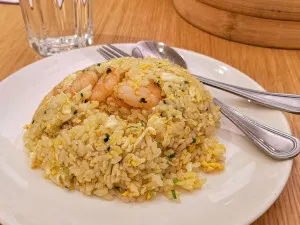
The idea to write this post was sparked during dinner when I ordered a plate of shrimp fried rice last week in a Michelin-awarded restaurant. The fried rice was good, but I have pre-visualized my dream fried rice, which looks and tastes differently.
Improvise a restaurant-style shrimp fried rice
So I have a daring attempt to improve the fried rice of a famous restaurant to yield the dream shrimp fried rice pictured in my mind. (Note: I am not trying to challenge any award-winning restaurant, but I want to develop my version by building on a masterful plate of fried rice from this restaurant and saving time creating from scratch.)
I hope this post is equally useful for anyone who wishes to improvise a great recipe with your personal touch.
The dish’s essence remains – plenty of shrimp and eggs, and the rice is soft and chewy, but I switch it up with beans and carrot cubes and add plenty of minced garlic and chopped scallions.
Here is the final result:
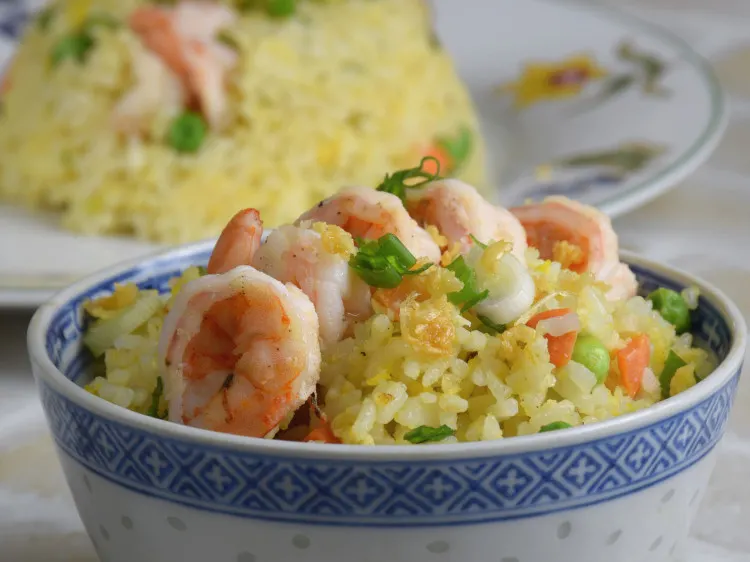
Note: This post may contain affiliate links. Please read my privacy policy for more info. I may receive commissions for purchases made through links in this post. As an Amazon Associate, I earn from qualifying purchases.
Here is my method on how to upgrade the fried rice
- The shrimp are not seasoned with salt and look cooked by boiling them or pan-fried briefly. I will try to season it with salt and sear both sides until slightly brown.
- Pan-fried the shrimp in oil and used the shrimp’s oil to fry the rice. The rice will absorb the flavor of the shrimp.
- Coat the rice with the egg yolks. I like the color Golden Fried rice which is popular in Hong Kong. So I think it is a good idea to coat the rice with egg yolk to let the rice has a bright yellow color.
- Separate the egg whites from the yolks. Fry the egg whites until turns into white strips. Break it into small pieces and mix it with the rice. This method will add color to the rice, making it look more appetizing.
- Scallion has an excellent flavor to complement fried rice. Use scallion to fry the rice as well as for garnishing.
- There is insufficient wok aroma of what I have in the restaurant. I would prefer to have more wok aroma by frying it over high heat at the end of the cooling process.
- I prefer a more colorful presentation, adding some diced carrots, corn, and green peas. That also gives shapes and dimensions to the shrimp fried rice.
- Perfectly pan-fried garlic which is crispy and golden brown, is used to prepare Japanese garlic fried rice. I will add this to the recipe to add flavor and color.
How to cook excellent fried rice (the detail of each step)
1. Fried the garlic
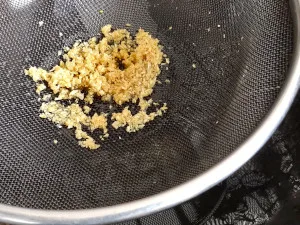
Garlic is the most common one, followed by shallot. I use only garlic only in this recipe.
Mince or chop the garlic. Saute the chopped garlic over low heat until it is crispy and golden brown. Stain the garlic through a wire mesh strainer and keep aside. I will fry the garlic separately so that the garlic is clean and tidy for garnishing. Use the garlic flavor oil to pan-fry the shrimp subsequently.
Alternatively, you can cut the garlic thinly, fry it until golden brown, shatter it into pieces, and sprinkle it on the rice.
If you want chopped shallot, I suggest caramelizing it slightly in the wok before adding the rice at the initial stage.
2. Season and brown the shrimp
Fresh shrimp is the best, although it is not mandatory. Nevertheless, use frozen shrimp if you cook with day-old rice and other foods in your refrigerator.
The price of fried rice shrimp normally depends on the size of the shrimp. Throwing in a few large shrimp will guarantee a higher price in restaurants. As for the home cooks, I suggest using medium-sized shrimp, which taste equally good.
Clean the fresh shrimp the standard way – remove the head, shells, and devein. Some people prefer to leave the tail on for better presentation, but it is not practical as no one prefers to have bone and shelves in the fried rice.
Some cooks will throw the raw shrimp into the wok and start stir-frying, then add the remaining ingredients. While this is a quick way to cook, I prefer to pan-fry both sides of the shrimp and season with salt and pepper. Remove from the pan/wok, and add to the rice later. Searing shrimp with garlic oil can develop a better flavor. Remove it from the wok at this stage, keep them clean, and prevent overcooking.
3. Pick the suitable types of rice to prepare fried rice
You can fry leftover white rice or freshly steamed rice, but the method is slightly different. Long grain rice / Jasmine rice is the most suitable type to prepare all Chinese fried rice.
a. Leftover rice (next day rice)
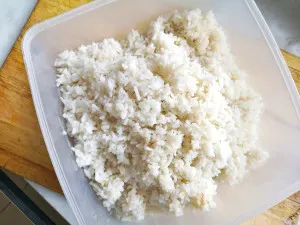
Remove the leftover rice from the fridge in advance, as it can be cold and hard. Once it returns to room temperature, gently break the lumps with your clean hands (or gloves) to separate the rice grains. We want to coat each grain with the egg yolk, an essential step.
b. Use freshly cooked rice
On the other hand, if you intend to fry a large batch of rice, cook the rice specifically for this purpose.
You may want to cook the rice a little drier than steamed rice. Rice with too much moisture tends to stick easily to the wok. To do this, wash the rice with plenty of water until the water runs clear. There are two purposes why you need to clean the rice. First, it removes any dirt and debris, if any. Secondly, it also washes away the starch. Too much starch can be quite sticky and difficult to fry.
After cooking the rice, spread it on a large tray in a single layer to let the moisture escape quickly.
4. Reduce the stickiness of the rice
- Use a different type of rice. If you want the fried rice to be sticky, e.g., Japanese garlic fried rice, rinse only once or twice to retain part of the starch. The rice will be stickier.
- Rinse away the starch. Rinse with plenty of water to remove as much starch as possible if you want the rice to be less sticky. The choice is yours. The Japanese like to use short-grain rice, which is more sticky, whereas the Chinese prefer long-grain rice, which is less starchy.
I prefer to be less sticky, so I washed the rice until the water ran clear.
After the rice is cooked, please remove it from the rice cooker and spread it thinly on a large metal tray. Please place it in an open area or under the fan. This step can let the steam escape quickly, and the texture will become more or less like the leftover rice.
5. Break the lumps
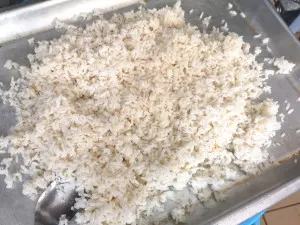
Whether you use overnight rice or freshly cooked rice, separate the sticky lumps of rice into individual grains as much as possible. Using the metal wok spatula to break up the lumps is bad, as this action will break the rice grains. The rice will not look presentable.
Large lumps of rice are not suitable for frying. The eggs will not effectively coat the rice grains, and the heat cannot reach the rice within the lumps. The fried rice will not be aromatic and evenly seasoned
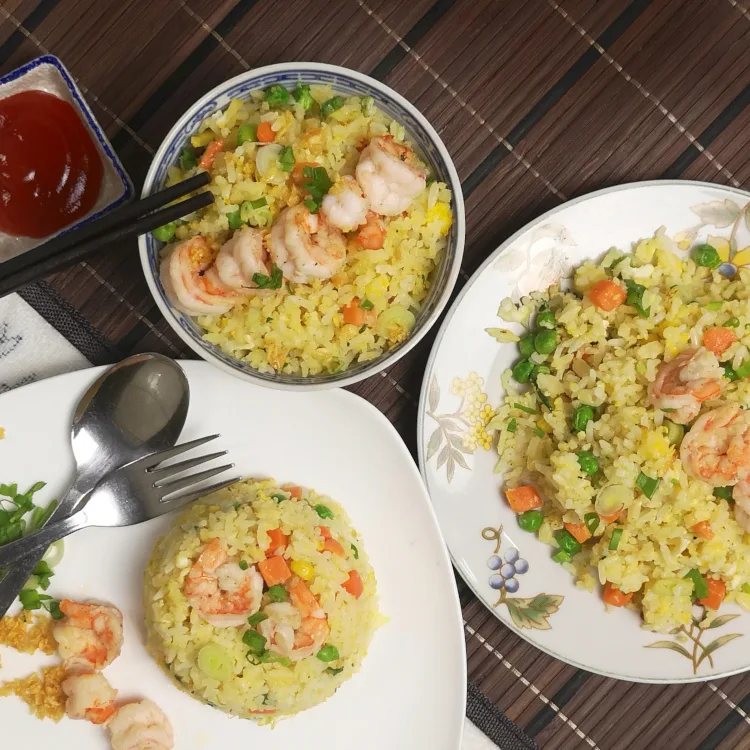
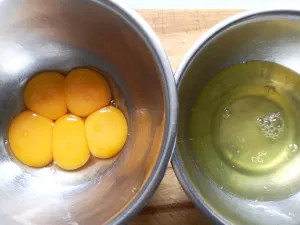
6. Different ways to add the eggs to the fried rice
There are two common ways to add eggs to shrimp fried rice. For example, the egg white fried rice I tried in Hong Kong, was only cooked with egg white. So keep it open and choose a way that you like.
- Method 1: Make a scrambled egg, break it with the wok spatula into small pieces, and then mix it with the rice. You will see individual pieces of egg.
- Method 2: Mix the raw eggs with the cooked rice. Let the egg coats the rice grains. The egg will form a thin layer on the surface of the rice, turning them into yellowish pearls.
I am the proponent of method 2, i.e., separating the yolk and the white.
Here are the steps:
a. The egg yolk
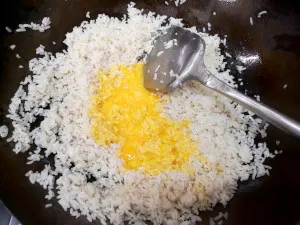
– Separate the egg yolks from the white.
– Add the egg yolks to the rice with some oil in the wok. Mix the rice with the yolks over low heat. Stir and flip to prevent it from sticking.
– Stir and flip until the egg yolk is set. Now each rice grain is coated. You can visualize hundreds of small omelets encased in the rice within.
– Now, you can stir-fry the rice over high heat. The egg protects the starch from the rice from contacting the wok’s surface. Therefore, it will never stick even over high heat (and does not need to add additional oil).
b. The egg white
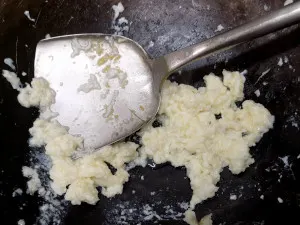
– Remove the rice from the wok.
– Add some oil and start to fry the egg white.
– Use the wok spatula to break the egg white into small pieces once it turns opaque.
– Return the rice to the wok and stir-fry with the egg whites.
7. The vegetables
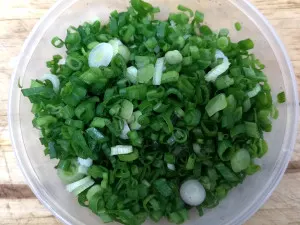
Fried rice does not need plenty of fresh vegetables. We use kangkong (water spinach) for the Indonesian-style fried rice (called nasi goreng). Apart from this, leafy vegetables are not a common ingredient.
Most Chinese fried rice includes plenty of chopped scallion, with no exception to this recipe.
We often underestimate the amount of scallion required, as the abundance of chopped scallion will quickly wither and vanish in the rice. There is not too much scallion; by all means, use the green and white sections.
I also added some diced carrots, corn, and green peas. They may not be the traditional ingredients for authentic Chinese fry rice, but this combination drastically improves the appearance of fried rice. The mixed beans are becoming popular among Chinese, Indonesian, and Malay fried rice due to their colorful presentation.
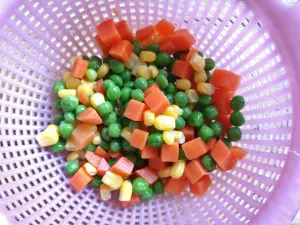
Leafy vegetables (lettuce, choy sum, etc.) are not very suitable to pair with other ingredients. If you want, cut them into short pieces so that they will mix with the rice quickly.
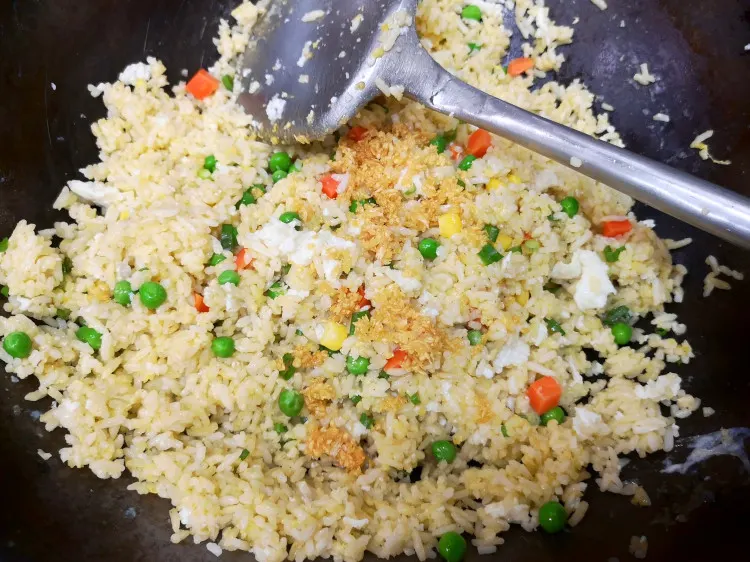
Other important aspects of cooking fried rice
1. Use chicken or pork instead of shrimp to fry the rice
The most common meat item in Chinese fried rice is barbecue pork (Char Siu, 叉烧). The famous Young Chow Fried Rice include shrimp and Char Siu, although many claims that the Young Chow fried rice does not use them. People often take this shrimp fried rice as synonymous with Chinese fried rice, which is not the case. There are many different ways to prepare fried rice in Chinese besides Young Chow fried rice.
Besides pork, other common meat items are beef and chicken.
2. Type of oil that is suitable for stir-frying
Peanut oil, corn oil, and palm oil are all suitable for this recipe. These oils have a high smoking point, which is stable even stir-frying at high heat, which is recommended.
If you are concerned about the health aspects of some oils, you can use olive oil. However, you must be careful not to fry the rice at high heat as it has a lower smoking point. Since only high temperatures can generate the signature wok aroma, it may not resemble what you get at Chinese restaurants. Besides, olive oil does not have a neutral flavor, which may not be considered an authentic ingredient for Asian fried rice. Nevertheless, you might not want to follow a recipe squarely and make any change as long as you like it.
3. The cooking utensils
The best cooking utensil for fried rice is a well-seasoned cast iron wok. A well-seasoned wok has a nonstick surface and is suitable for frying over high heat. The round bottom of the wok will prevent the rice from falling off the edge during stir-frying.
A large cast iron skillet or a large skillet can be the alternative to the wok. A non-stick pan comes third as it cannot withstand high heat, although it can prevent the rice from sticking to the pan.
How to cook the shrimp fried rice to get the best result
This serves as the step-by-step guide to this recipe.
1. Garlic and shrimp
Add two tablespoons of vegetable oil to a small pan over low heat.
- Add one tablespoon of minced/chopped garlic and saute it slowly until it turns golden brown. This step is delicate as the garlic burns quickly over high heat.
- Remove the garlic from the oil immediately when it reaches the desired golden color. Otherwise, the garlic will become too dark and bitter.
- Pour the fried garlic through a wire mesh strainer. Keep the garlic and use the oil for cooking the shrimp in the wok.
- Add some salt and white pepper to the shrimp and mix well.
- Arrange the shrimp in the pan and sears both sides slowly until they are slightly charred. Keep it low to medium heat, so you have better control of the doneness of the shrimp. Once they turn slightly golden, remove the cooked shrimp and keep them aside.
You may wonder why I do not cook the garlic and shrimp in the wok, which is subsequently used for frying the rice.
Yes, I can do that, which is how we cook a large quantity in the restaurant. However, I am looking for the best result, and by frying the garlic in a separate pan, I can ensure that the garlic and the shrimp have a clean finish. This method yields a better presentation, and I think it should be the way to go for fine-dining standard fried rice. (When you go for a five-course omakase, you will not want to see even a speck of burnt garlic in the shrimp fried rice, don’t you? ).
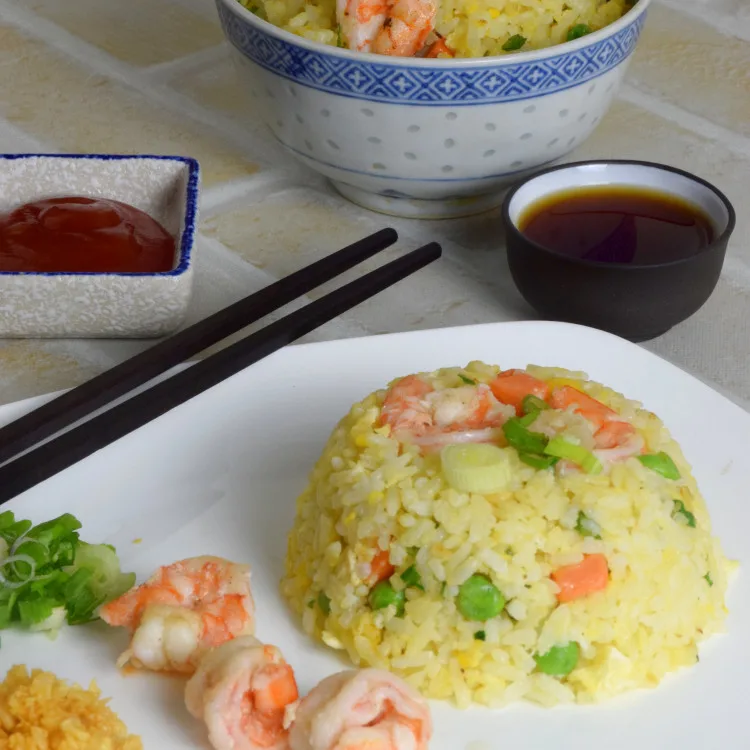
2. The eggs
Next, Pour the garlic shrimp oil into the pan in the wok.
- The shrimp and garlic oil plays an essential role in flavoring the rice. The concept is similar to preparing agleo e oleo pasta, in which oil is used to flavor the pasta. In this case, the oil will flavor the rice.
- Crack two eggs. Separate the yolk from the whites. Add the yolks and all the cooked rice to the wok over low heat. Mix the rice with the egg quickly before the egg yolk hardens. Let the egg yolk coat the surface of each rice grain.
- This step ensures every rice grain turns yellowish, with a thin layer of omelet encasing the rice inside. It not only makes it look attractive but protects the rice within and prevents it from sticking to the wok, even stir-fries, over high heat.
- Increase the heat slowly. The beaten eggs will stick to the wok if the temperature is too high. Reduce the heat if it sticks until the egg is fully cooked before putting it on higher heat again.
- Push the rice to the side of the wok. Add the egg white to the center and quickly stir with the spatula to form it into short strands.
Why do I separate the egg white from the yolks? The primary reason is for a better presentation. By doing so, you will get the rice coated with egg yolk (yellow) and scattered with strands of egg whites. This concept is taken from the golden fried rice (黄金炒饭) that is famous in Hong Kong.
3. Add the seasonings
- Once the eggs are fully cooked, turn up the heat.
- Season the rice with salt.
- At this stage, you can also add some premium-grade light soy sauce. However, the color of bright yellow rice grains will be darkened. You may add some oyster sauce. I would prefer to use only the premier-grade light soy sauce.
Therefore, the use of soy sauce depends on whether you want to keep it clean and straightforward or wish to have a more complex flavor. I prefer the beautiful bright yellow and am happy with the garlic and shrimp taste.
4. The final touch
- Lastly, add some mixed beans if you want. Finally, return the shrimp and the fried garlic to the wok.
- Add the chopped scallions (green onions).
- You can add a teaspoon of sesame oil if you prefer.
- Turn to high heat and stir fry for half a minute.
- For plating, you can arrange the shrimp on top of the rice and garnish with more chopped scallions and fried garlic.
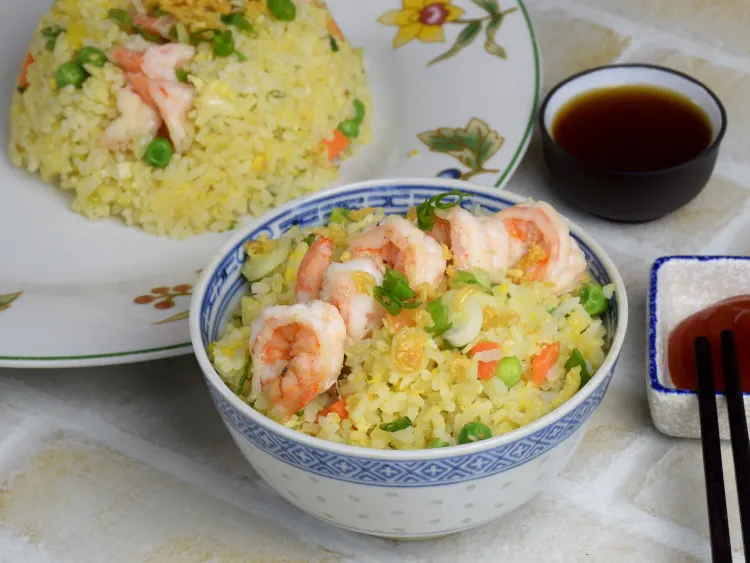
The Shrimp Fried Rice Recipe
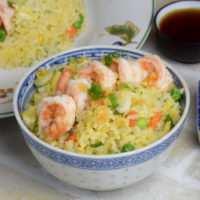
The Shrimp Fried Rice Recipe
This is the switch up version of the restaurant style shrimp fried rice, with added fried garlic, mixed bean and coated the ice with egg yolks.
Ingredients
- 250 g cooked rice
- 2 tbsp vegetable oil
- 1 tbsp garlic, chopped
- 6 shrimps, medium size, clean and devein
- 2 eggs
- 2 tbsp chopped scallions
- 40 g mixed beans, (carrots, green peas, corns)
- 1/2 tsp salt
Instructions
- Add two tablespoons of vegetable oil to a small pan over low heat.
- Add one tablespoon of minced/chopped garlic and start to saute it slowly until it turns golden brown. Remove the garlic from the oil immediately by pouring the fried garlic through a wire mesh strainer. Keep the garlic and use the oil to cook the shrimp in the wok.
- Add some salt and white pepper to the shrimp and mix well.
- Arrange the shrimp in the wok and sears both sides slowly until they are slightly charred. Remove and keep aside.
- Crack two eggs. Separate the yolk from the whites.
- Add the yolks and all the cooked rice to the wok over low heat. Mix the rice with the egg quickly before the egg yolks harden.
- Increase the heat slowly. Push the rice to the side of the wok. Add the egg white to the center, and have a quick stir with the spatula to form it into short strands.
- Season the rice with salt.
- Add some mixed beans and chopped scallions. Return the shrimp and the fried garlic to the wok.
- Turn to high heat and stir fry for half a minute. Dish out.
- Arrange the shrimp on top of the rice, and garnish with more chopped scallions and fried garlic.
Recommended Products
As an Amazon Associate and member of other affiliate programs, I earn from qualifying purchases.
Nutrition Information:
Yield: 1 Serving Size: 1Amount Per Serving: Calories: 945Total Fat: 39gSaturated Fat: 6gTrans Fat: 1gUnsaturated Fat: 31gCholesterol: 435mgSodium: 1706mgCarbohydrates: 109gFiber: 13gSugar: 11gProtein: 38g
This data was provided and calculated by Nutritionix on 6/16/2019

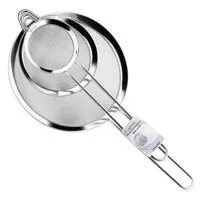
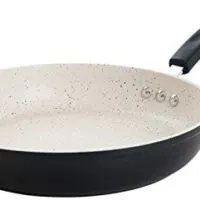
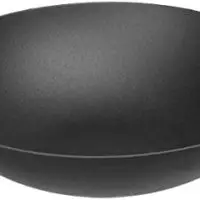
Basil fried rice recipe- How to cook in 20 minutes (best Thai street food)
Sunday 29th of September 2024
[…] How to cook Chinese fried rice. This article will give you more tips on cooking the best fried rice. […]
kingsley
Tuesday 27th of August 2019
I love all this and I want to learn more
KP Kwan
Tuesday 27th of August 2019
You are welcome!
Yang Chow fried rice - How make cook wthout using high power stove
Sunday 2nd of December 2018
[…] out these articles which provide all the information you need to prepare Chinese fried rice: 1. Shrimp fried rice – how to cook to get the best result (trade secrets) 2. How to cook the best Chinese fried rice with only six ingredients 3. How to cook the best […]
eric
Wednesday 31st of October 2018
Thanks KP Kwan for your reply. You are one of those rare people who explain things so clearly. It takes a lot of effort to be able to do that. It is your strength and gift. Inspiring. God bless you. eric
KP Kwan
Thursday 1st of November 2018
You are welcome, Eric. All the best.
eric
Tuesday 30th of October 2018
Hi KP Kwan Mouth-watering fried rice. And the instructions were so clearly presented. May I ask a question: How to recognise a cast iron wok- is the original colour of the wok black when you first bought it ? Thanks very much for sharing your ideas on how to make Asian food go to the next level. Two thumbs up!
KP Kwan
Tuesday 30th of October 2018
Hi Eric, Thanks for dropping by at my post about shrimp fried rice. The new cast iron wok is not as dark as what you see in the video. Once you purchase the wok, clean it and apply a thin layer of oil (with a brush or paper) and heat it on the stove. The heat should be sufficient until you can see smoking rising. Tilt the wok from time to time so that all part of the wok will be heated up. The high heat will cause a chemical reaction between the oil and the iron of the wok to form a layer on the surface. The chemical changes will also darken the color of the wok. This process is called season the wok. Keep heating it to about 10 minutes, remove from heat to cool. Wash with water. You will see the water forms droplets on the surface and slip away. It is now no--stick! If you want, dry the wok and repeat the same process once more. This additional step will thicken the coating. Now it is ready to use.
Hope this helps.
KP Kwan